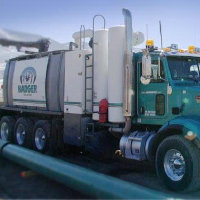
Badger Infrastructure Solutions Ltd
TSX:BDGI


| US |

|
Johnson & Johnson
NYSE:JNJ
|
Pharmaceuticals
|
| US |

|
Berkshire Hathaway Inc
NYSE:BRK.A
|
Financial Services
|
| US |

|
Bank of America Corp
NYSE:BAC
|
Banking
|
| US |

|
Mastercard Inc
NYSE:MA
|
Technology
|
| US |

|
UnitedHealth Group Inc
NYSE:UNH
|
Health Care
|
| US |

|
Exxon Mobil Corp
NYSE:XOM
|
Energy
|
| US |

|
Pfizer Inc
NYSE:PFE
|
Pharmaceuticals
|
| US |

|
Palantir Technologies Inc
NYSE:PLTR
|
Technology
|
| US |

|
Nike Inc
NYSE:NKE
|
Textiles, Apparel & Luxury Goods
|
| US |

|
Visa Inc
NYSE:V
|
Technology
|
| CN |

|
Alibaba Group Holding Ltd
NYSE:BABA
|
Retail
|
| US |

|
JPMorgan Chase & Co
NYSE:JPM
|
Banking
|
| US |

|
Coca-Cola Co
NYSE:KO
|
Beverages
|
| US |

|
Walmart Inc
NYSE:WMT
|
Retail
|
| US |

|
Verizon Communications Inc
NYSE:VZ
|
Telecommunication
|
| US |

|
Chevron Corp
NYSE:CVX
|
Energy
|
Utilize notes to systematically review your investment decisions. By reflecting on past outcomes, you can discern effective strategies and identify those that underperformed. This continuous feedback loop enables you to adapt and refine your approach, optimizing for future success.
Each note serves as a learning point, offering insights into your decision-making processes. Over time, you'll accumulate a personalized database of knowledge, enhancing your ability to make informed decisions quickly and effectively.
With a comprehensive record of your investment history at your fingertips, you can compare current opportunities against past experiences. This not only bolsters your confidence but also ensures that each decision is grounded in a well-documented rationale.
Do you really want to delete this note?
This action cannot be undone.

| 52 Week Range |
34.82
78.78
|
| Price Target |
|
We'll email you a reminder when the closing price reaches CAD.
Choose the stock you wish to monitor with a price alert.

|
Johnson & Johnson
NYSE:JNJ
|
US |

|
Berkshire Hathaway Inc
NYSE:BRK.A
|
US |

|
Bank of America Corp
NYSE:BAC
|
US |

|
Mastercard Inc
NYSE:MA
|
US |

|
UnitedHealth Group Inc
NYSE:UNH
|
US |

|
Exxon Mobil Corp
NYSE:XOM
|
US |

|
Pfizer Inc
NYSE:PFE
|
US |

|
Palantir Technologies Inc
NYSE:PLTR
|
US |

|
Nike Inc
NYSE:NKE
|
US |

|
Visa Inc
NYSE:V
|
US |

|
Alibaba Group Holding Ltd
NYSE:BABA
|
CN |

|
JPMorgan Chase & Co
NYSE:JPM
|
US |

|
Coca-Cola Co
NYSE:KO
|
US |

|
Walmart Inc
NYSE:WMT
|
US |

|
Verizon Communications Inc
NYSE:VZ
|
US |

|
Chevron Corp
NYSE:CVX
|
US |
This alert will be permanently deleted.
Badger Infrastructure Solutions Ltd
Badger Infrastructure Solutions Ltd. engages in the provision of soil excavation servces. The company is headquartered in Calgary, Alberta and currently employs 2,119 full-time employees. The firm's Badger Daylighting technology is an essential service provider to North America’s infrastructure. The Company’s market segment consists of infrastructure projects in areas such as energy generation, electricity and natural gas transmission networks, roads and highways, telecommunications, water and sewage treatment and general municipal infrastructure. The firm delivers a range of services and applications including daylighting, utility pole holes, slot trenching, service pits, trenching, debris removal, anode installations, shoring installations, pipeline crossing, pipeline tie-ins, tank cleanouts and emergency response. The company provides services to a diverse customer base, including oil and gas, energy, industrial, construction, transportation and other markets, as well as numerous government agencies within Canada and the United States.

Badger Infrastructure Solutions Ltd. engages in the provision of soil excavation servces. The company is headquartered in Calgary, Alberta and currently employs 2,119 full-time employees. The firm's Badger Daylighting technology is an essential service provider to North America’s infrastructure. The Company’s market segment consists of infrastructure projects in areas such as energy generation, electricity and natural gas transmission networks, roads and highways, telecommunications, water and sewage treatment and general municipal infrastructure. The firm delivers a range of services and applications including daylighting, utility pole holes, slot trenching, service pits, trenching, debris removal, anode installations, shoring installations, pipeline crossing, pipeline tie-ins, tank cleanouts and emergency response. The company provides services to a diverse customer base, including oil and gas, energy, industrial, construction, transportation and other markets, as well as numerous government agencies within Canada and the United States.
Record Revenue: Badger delivered record Q3 revenue of $237.3 million, up 13% year-over-year, supported by strong demand across end markets.
Profit Growth: Adjusted EBITDA rose 15% year-over-year, with margin expanding 40 basis points to 28.2%, reflecting operational efficiency.
EPS Jump: Adjusted earnings per share reached $0.91, up 25% compared to last year.
Fleet Investments: Hydrovac fleet grew 5% year-over-year to 1,703 units; hydrovac production guidance was raised to the upper end of the original 180–210 range.
Increased CapEx: 2025 capital spend guidance was raised to $115–130 million from $95–115 million.
Data Center Exposure: Data center-related work comprised about 10–11% of business, with 6–8% directly tied to data centers.
Tariff Impact: Management stated tariffs have had no effect so far; potential worst-case impact on EPS is estimated at 1–3%.
Canadian Market Recovery: Noted improving conditions in Canada, particularly with renewed large project and infrastructure spending.

































